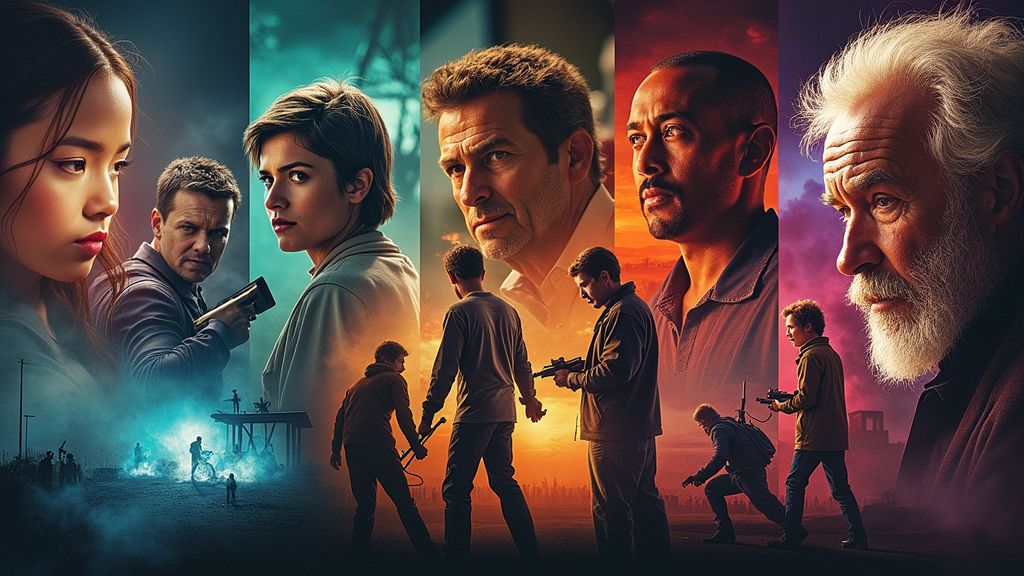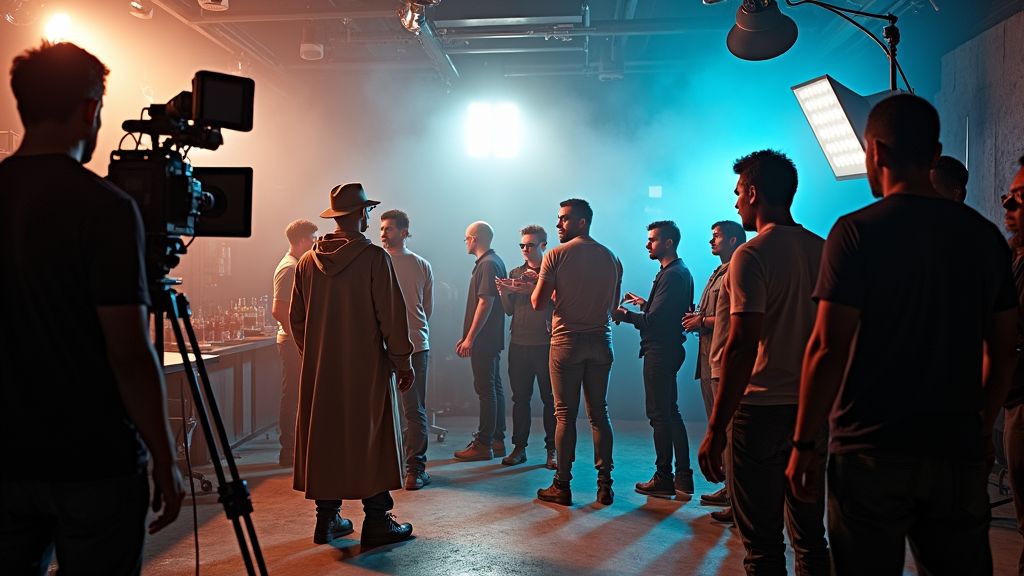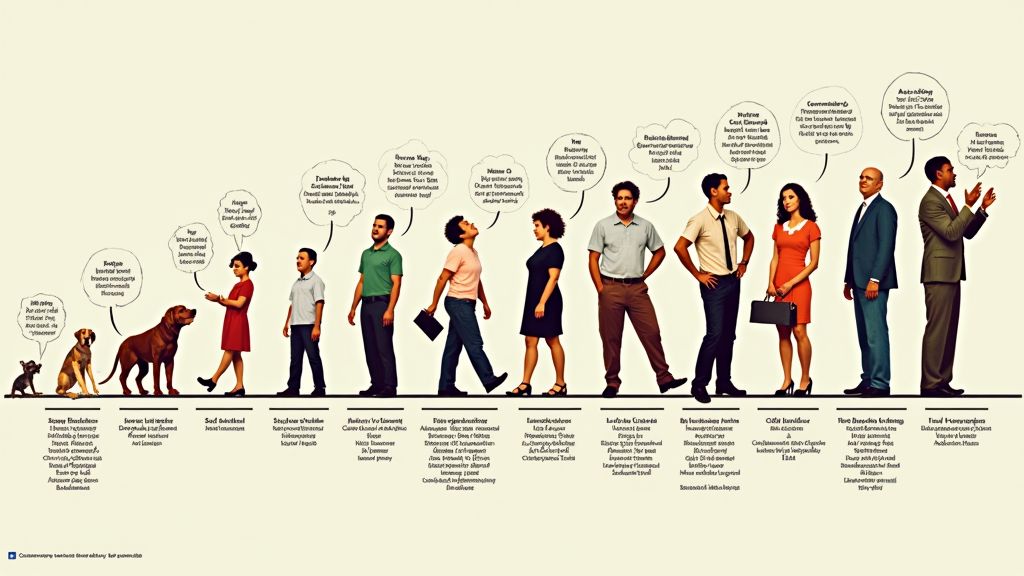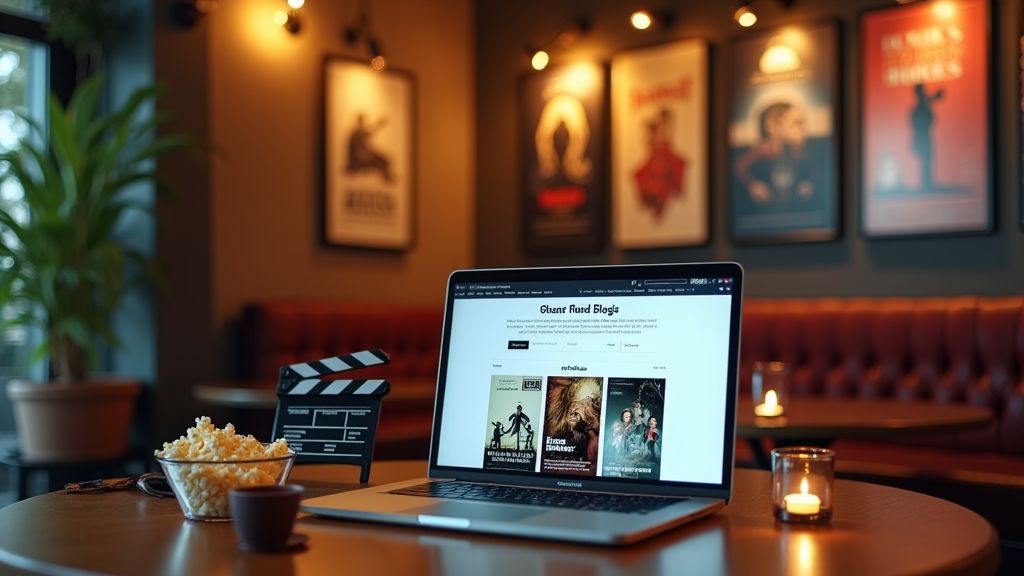Advertisement
Entertainment
The Art of Storytelling in Modern Cinema
Have you ever watched a movie that moved you to tears or left you in awe, wondering how it managed to touch your heart? Welcome to the captivating world of modern cinema where the art of storytelling reigns supreme. Today, we’re exploring how storytelling in films has evolved and how it continues to shape our lives, one movie ticket at a time.

The Evolution of Storytelling in Films
Cinema has come a long way since the era of black-and-white silent films. From simple narratives narrated by title cards, we’ve now evolved to intricately woven storylines powered by visual effects and stunning cinematography. How did this transformation happen, and what lessons can we learn from it?
Well, it all began with an innate human need for narrative. As Joseph Campbell famously highlighted in his monomyth theory, storytelling across cultures often follows a ‘hero’s journey,’ a template that’s still pervasive in many blockbusters today. Human beings have always sought stories that resonate with universal experiences—birth, death, love, conflict, redemption—and these themes are what make certain films timeless. From the very first days of cinema, inventors and pioneers like the Lumière brothers and Georges Méliès recognized that visuals could convey emotion just as effectively, if not more so, than words on a page. Méliès’s imaginative approach to filmmaking introduced fantastical elements and set the stage for generations of filmmakers to come.
In the early 20th century, the advent of ‘talkies’ (movies with synchronized sound) revolutionized the industry. This breakthrough opened the door for more elaborate plots, richer characters, and deeper emotional undertones. Audiences no longer relied solely on intertitles to follow the narrative; they could hear the actors speak, sing, or even cry. The Golden Age of Hollywood soon followed, characterized by lavish productions, star-studded casts, and a film-centric culture that permeated everyday life. It was during this era that major studios like MGM, Paramount, and Warner Bros. cemented their reputations by churning out classics that would influence cinema forever.
But storytelling didn’t stop evolving there. As society changed, so did the stories portrayed on screen. The social upheavals and cultural shifts of the 1960s and 1970s, for instance, encouraged filmmakers to explore more experimental narratives, often questioning traditions and norms. Directors like Alfred Hitchcock, Federico Fellini, and Akira Kurosawa pushed the boundaries of visual storytelling by introducing new angles, pacing, and camera techniques that imbued their films with distinct atmospheres and emotional depth.
In the 1980s and 1990s, the rise of blockbuster films (think ‘Jaws,’ ‘Star Wars,’ ‘Indiana Jones’) showcased the immense power of spectacle, special effects, and high-concept storytelling. Audiences began flocking to theaters in record numbers for these larger-than-life tales. Meanwhile, the independent film movement flourished on the fringe, demonstrating that smaller, more intimate stories could also garner critical acclaim—films like ‘Pulp Fiction’ and ‘Reservoir Dogs’ proved that audiences craved freshness and originality.
Today, we’re in the era of digital technology, CGI, and streaming platforms. Filmmakers and screenwriters continue to innovate, weaving narratives that reflect the complexity of our modern world. From deeply personal stories to epic, universe-spanning sagas, the cinematic landscape offers something for everyone. Yet, at the core of every successful film remains a powerful narrative, true to that fundamental human desire for a well-told tale.
Key Aspects of Modern Storytelling
- Character Development: Characters with depth and relatable journeys capture our hearts. Think of how Katniss Everdeen in ‘The Hunger Games’ evolves from a reluctant participant to a fierce leader. Well-constructed characters often undergo significant internal and external growth, resonating with audiences long after the credits roll. By watching these transformations, we reflect on our own personal growth and aspirations.
- Emotional Engagement: Movies that create emotional connections leave a lasting impact. Who could forget the poignant moments in ‘The Pursuit of Happyness’? Whether it’s joy, sorrow, or hope, tapping into core human emotions elevates a film from entertaining to unforgettable. The use of well-crafted musical scores—like the emotive pieces by composers such as John Williams or Hans Zimmer—further amplifies our emotional investment.
- Visual and Sound Effects: Thanks to modern advancements, what was once impossible can now be achieved on screen, from the intricate worlds in ‘Avatar’ to the roaring dinosaurs in ‘Jurassic Park.’ These effects enhance storytelling, making it vivid and immersive. However, these high-tech elements shouldn’t overshadow the narrative; the best special effects serve to complement the story rather than eclipse it.
- Narrative Twists: A good twist keeps viewers engaged and on the edge of their seats—think ‘Inception’ or ‘The Sixth Sense.’ Twists challenge our assumptions and offer a fresh perspective, often prompting us to revisit the film to catch all the subtle clues we might have missed the first time. In an age of endless content, well-placed twists can make a film stand out among the crowd.
Applying Cinema’s Storytelling to Daily Life
You might be wondering, how can we emulate these storytelling techniques in our everyday lives? I’m glad you asked! Whether you’re crafting a presentation, writing a blog post, or just telling a great story at a gathering, these tips can make your narrative more engaging:
- Emphasize the Journey: Highlight the process rather than just the outcome. Everyone loves to hear a good underdog story. Share the struggles, challenges, and the moments of learning along the way. These details humanize your narrative and help listeners connect with your experiences on a personal level.
- Invoke Emotion: Connect on a personal level by engaging emotions. Use anecdotes or humor to get your point across. If your audience can feel what you’re feeling—whether it’s frustration, excitement, or relief—they’ll stay invested in what you have to say.
- Be Visual: Use vivid descriptions or, if possible, actual images or props to make your story more compelling. Show, don’t just tell. Like cinema, a well-told tale in everyday life can benefit from strong imagery, be it metaphorical or literal.
- Surprise Elements: Keep your audience guessing with unexpected twists. This doesn’t need to be as dramatic as a movie twist, but a little surprise can keep things interesting! Perhaps a last-minute revelation or an amusing side note can be just enough to perk up your listeners.
Common Concerns: Breaking Cinema Storytelling Stereotypes
One potential pitfall in film storytelling is reliance on clichés and stereotypes. Not every hero has to be a ‘reluctant young man’ or ‘doomed to a tragic fate.’ The modern audience craves variety and authenticity. Thus, breaking the mold can set your story apart.
“Cinema is not a slice of life, but a piece of cake.” – Alfred Hitchcock
Avoiding stereotypes doesn’t mean stripping stories of their essence; instead, it means redefining them with a contemporary touch that mirrors reality’s diversity. Filmmakers who successfully subvert expectations often leave a more profound imprint on viewers’ minds. Movies like ‘Get Out’ or ‘Parasite’ garnered widespread critical acclaim partly because they stepped away from the tried-and-true tropes, delivering fresh, resonant narratives that spoke to broader social and cultural themes.
Additionally, representation on screen has become a major point of discussion in contemporary cinema. Audiences today want to see characters that mirror their own backgrounds, struggles, and triumphs—whether related to race, gender, or personal identity. This call for inclusive storytelling is transforming the industry from the inside out, making room for filmmakers, writers, and actors who have historically been underrepresented. The result is a richer tapestry of stories reflecting the world’s vibrant diversity.
What Can We Learn from Case Studies?
Let’s take a closer look at the success of Marvel Studios. By creating interconnected storylines across multiple films, Marvel has effectively built a cinematic universe that keeps audiences coming back for more. Their strategy of intertwining individual character narratives with a larger, overarching plot showcases the power of a well-planned storyline. Each movie serves as a puzzle piece, contributing to a grander picture. Audiences are eager to follow each character’s journey, not just because of the stand-alone film but because of how it ties into a wider narrative web. This approach encourages repeat viewings and fosters a sense of community among fans speculating about upcoming releases.
Conversely, films like ‘The Fault in Our Stars’ and ‘Lady Bird’ remind us of the potency of intimate storytelling, showing that you don’t necessarily need a superhero suit to be memorable. The emotional connections forged in smaller, more intimate films demonstrate that the scale of a production doesn’t necessarily dictate its success. By focusing on relatable human experiences and conflicts, these films create a personal bond between the audience and the characters, proving that good storytelling transcends both genre and budget.
Another compelling example is the surge in popularity of streaming services. Platforms like Netflix, Amazon Prime, and Disney+ have disrupted traditional cinema by offering an ever-expanding library of films and television series. Filmmakers now have more flexibility and creative freedom. They’re no longer strictly bound by the two-hour feature film format; episodic storytelling has given rise to cinematic television that can span multiple seasons, providing deeper explorations of characters and narratives. This shift also reflects changing viewer habits: many people prefer to binge-watch at home, pausing and resuming at their convenience. In turn, storytellers experiment with pacing, cliffhangers, and complex arcs to keep audiences engaged across multiple episodes.
On the flip side, the ease of accessing countless titles has created a more competitive landscape, with each show or film vying for a limited supply of audience attention. The result? Writers and directors often incorporate strong hooks right from the opening scene—akin to the ‘grabber’ in a piece of persuasive writing—because if a show doesn’t captivate within the first ten or twenty minutes, viewers may move on to something else. This phenomenon underscores how audience expectations shape the art of storytelling in modern cinema.
Delving Deeper: Pioneers of Cinematic Storytelling
It’s impossible to talk about modern cinema’s storytelling without paying homage to some of the great pioneers who shaped the medium. Directors like Orson Welles revolutionized narrative structure and visual language with films such as ‘Citizen Kane,’ which used non-linear storytelling and innovative camera techniques that challenged conventions. Jean-Luc Godard and other French New Wave directors broke established filmmaking rules, opting for jump cuts, on-location shooting, and improvisational dialogue that mirrored real-life rhythms. These bold choices not only gave their films a raw, energetic feel but also expanded the range of possibilities for storytelling on screen.
Meanwhile, creators like Walt Disney transformed how animated storytelling reached mainstream audiences. Films like ‘Snow White and the Seven Dwarfs’ or ‘The Lion King’ showed that animated tales could tackle universal themes of love, loss, and identity—often more poignantly than live-action films. Through cutting-edge animation techniques and strong emotional threads, these classics left an indelible mark on multiple generations. Today, animation studios like Pixar carry on this tradition by crafting narratives that enthrall both children and adults, weaving humor, pathos, and existential questions into visually stunning worlds.
The Impact of Cultural Shifts on Cinema
Cinematic storytelling also adapts in response to cultural, political, and social changes. Take, for instance, the post-war era in various countries: Italian Neorealism, epitomized by directors like Vittorio De Sica, reflected the harsh realities of everyday life in war-torn communities. Their films brought authenticity and grit to the screen, moving away from the glitz of Hollywood. Or consider the era of civil rights movements and counterculture in the 1960s and 1970s—the rebellious spirit of that time echoed in cinema, shaping films that questioned authority and portrayed anti-heroes grappling with existential crises.
In more recent times, the push for better representation and inclusivity in Hollywood parallels broader social movements that demand equality, justice, and a dismantling of longstanding barriers. Stories like ‘Black Panther’ or ‘Crazy Rich Asians’ broke box-office records and cultural barriers by centering narratives around characters and cultures that had been underrepresented on the big screen for decades. In doing so, they showcased the vast potential for success when storytelling is both innovative and inclusive.
From Script to Screen: The Collaborative Nature of Cinema
It’s worth noting that film storytelling is inherently collaborative. Unlike a novel, which may be written by a single author, a cinematic production involves a symphony of talents. Screenwriters craft the foundational narrative, directors shape its vision, cinematographers bring it to life visually, and editors piece it together into a cohesive whole. Actors breathe life into the characters, while sound designers, composers, and special effects artists layer in additional sensory depth. Each contributor leaves a creative imprint on the final product, which is part of what makes cinema so dynamic—and why every film is truly a one-of-a-kind tapestry of artistic vision.
This collaborative process also means that storytelling in film is a balancing act. Filmmakers must juggle commercial considerations (e.g., market demands, production budgets, target demographics) with creative integrity. Finding that harmony often leads to some of the most memorable cinematic experiences. When a film manages to seamlessly intertwine artistry and commerce—giving audiences what they want while challenging them to see the world in a new light—it transcends entertainment to become a cultural touchstone.
Challenges in Contemporary Cinema
Though modern technology has opened new doors for storytelling, it’s not without drawbacks. Blockbuster franchises can sometimes overshadow smaller, more experimental projects, forcing independent filmmakers to seek out niche audiences or alternative funding methods like crowdfunding. Additionally, the sheer volume of content available on streaming platforms can lead to ‘choice paralysis’ for viewers, who may be overwhelmed by endless titles. These challenges urge creators to continually rethink how they present and market their stories to stand out in a saturated market.
Moreover, while big-budget spectacles often dominate headlines, it’s the finely-tuned, character-centric stories that frequently win critical acclaim and awards. This dichotomy highlights the fact that there’s no single path to success in cinema. Some directors, like Christopher Nolan, manage to strike a balance between massive scale and intellectual depth, inviting audiences to ponder philosophical questions in the midst of jaw-dropping effects. Others, like Greta Gerwig, focus on intimate character studies that resonate with specific personal or cultural experiences, yet still draw widespread praise and box-office success.
Last Words of Silver Screen Wisdom
In summary, modern cinema’s storytelling offers insights not just for filmmakers but for anyone who wants to communicate effectively. By harnessing the power of emotional connections, character depth, and engaging narratives, you can transform any story into an experience. The evolution of cinema—from silent black-and-white reels to today’s digitally immersive spectacles—reflects the ever-changing tapestry of human life itself. By examining what works (and what doesn’t) on the big screen, we gain valuable lessons on how to tell better stories, whether we’re pitching an idea, sharing personal experiences, or even writing an email that needs to make an impact.
Feeling inspired? Next time you’re sharing your own story, think about the elements that captivate you in movies, and ask yourself how you can incorporate them. Do you have a strong protagonist, a clear conflict, a compelling resolution? Are you engaging your audience’s emotions, senses, and intellect? Are you offering a perspective that’s fresh and authentic? When we borrow these cinematic strategies—depth in characters, emotional resonance, visual engagement, and the occasional twist—we create stories that people remember.
Take the next step and reimagine how you share your tales—apply these cinematic storytelling techniques today!
Sources:
- https://www.josephcampbellfoundation.org
- https://www.marvel.com












